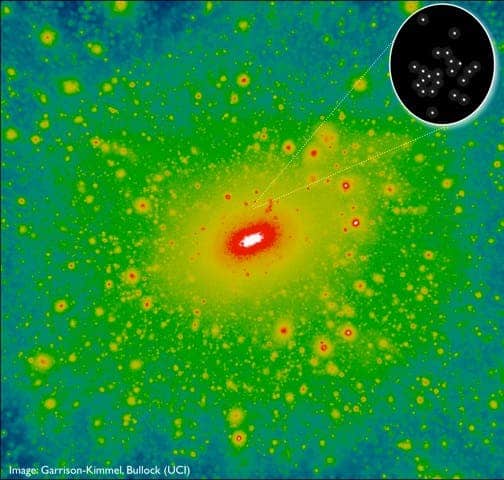An extremely rare and small galaxy has just been reported by astronomers, which by all accounts can be considered the least massive galaxy discovered thus far. The very faint galaxy, consisting of roughly 1,000 stars, supports current theories relating to the formation of the Universe.
Located in the constellation Aries, the dwarf galaxy dubbed Segue 2 barely emits 900 times the light of the sun. A tiny speck of light compared to the Milky Way’s bright hue that is 20 billion times brighter. To see it, astronomers had to use the most advanced and largest Earth-based telescopes at their disposal. In fact, it could have easily been mistaken for a star cluster were it not for the dark matter halo that acts as the galaxy’s glue.

This image shows a standard prediction for the dark matter distribution within about 1 million light years of the Milky Way galaxy, which is expected to be swarming with thousands of small dark matter clumps called halos. Observations of the ultra-faint galaxy Segue 2 (zoomed image) have revealed that it must reside within such a tiny dark matter halo.
CREDIT: Garrison-Kimmel, Bullock (UCI)
The finding is of great importance to scientists since it supports an important Universe formation theory that predict that the outskirts of our cosmic neighborhood, known as the Local Group, should be teeming with tiny galaxies. Segue 2 confirms this theory only partly, since “teeming” is a definite overstatement, as similar dwarf galaxies have proven to be extremely hard to spot. So hard to spot that astronomers have began to reconsider the validity of this theory.
“Finding a galaxy as tiny as Segue 2 is like discovering an elephant smaller than a mouse,” said James Bullock, a University of California, Irvine cosmologist.
Some astronomers believe Segue 2 might actually be the leftover remains of a larger galaxy that has been pared down by the savage pull of the Milky Way’s gravity. Bullock, on the other hand, called the finding “a tip-of-the-iceberg observation,” saying that there could be thousands more very low-mass star bodies orbiting the Milky Way, just beyond our ability to detect them. More galaxies like Segue 2 will need to be discovered nonetheless, else the dwarf galaxy might be classed as an anomaly.
The lightest galaxy discovered thus far was reported in a paper published in The Astrophysical Journal.









